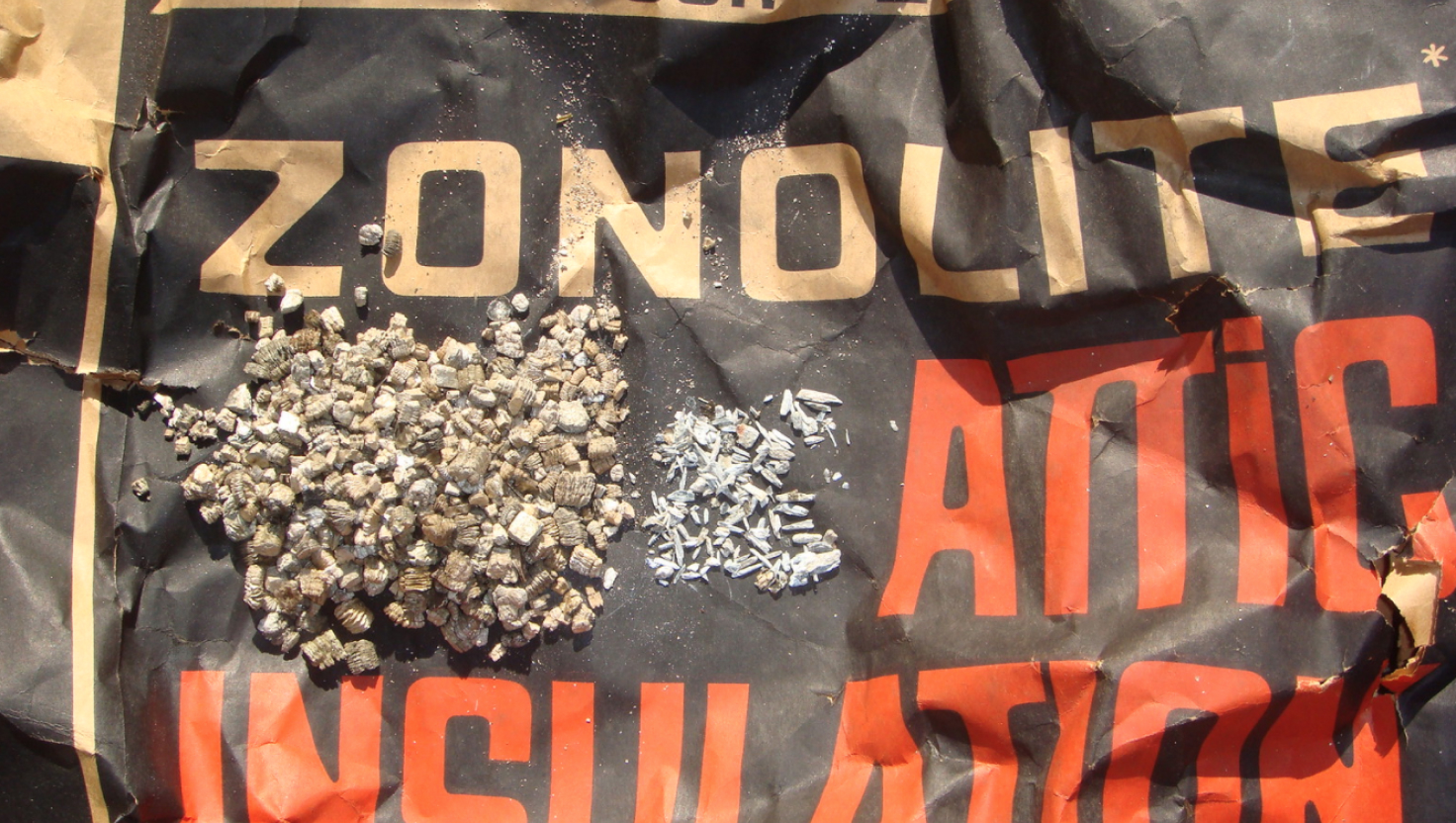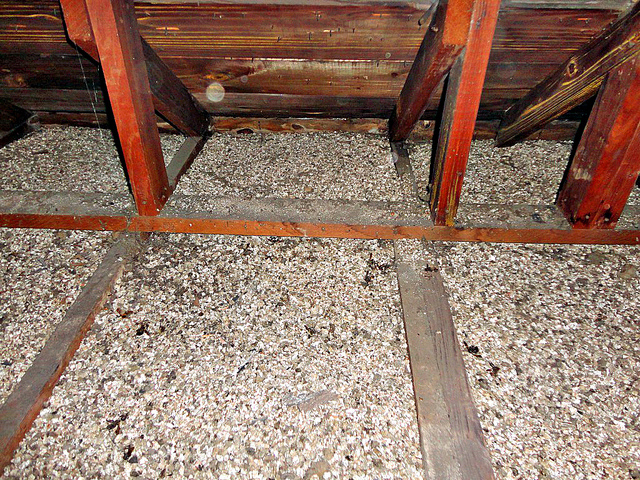Get Your Free Mesothelioma Guide

Find a Top Mesothelioma Doctor

Access Help Paying for Treatment

Zonolite is a trademarked brand name of a vermiculite attic insulation that was sold between the 1940s and 1990s. Zonolite is contaminated with tremolite, a highly toxic type of asbestos. While no longer produced, as many as 35 million U.S. homes and buildings may still contain Zonolite.

W.R. Grace and Company produced a type of loose-fill insulation called Zonolite with vermiculite from a mine in Libby, Montana, that was contaminated with tremolite asbestos. Vermiculite is a naturally occurring mineral with a silver-gold or light brown color.
Zonolite is designed to be poured onto an attic floor. Though it is no longer made, it was widely used and can still be found in millions of homes across the U.S.

Vermiculite and asbestos have much in common: Both are resistant to fire and chemical corrosion, and both make excellent insulating materials. Pure vermiculite is harmless, but exposure to vermiculite contaminated with asbestos can cause asbestos-related diseases.
Libby became so contaminated with asbestos that the U.S. Environmental Protection Agency has been cleaning up the town since 1999. The agency declared Libby a public health emergency in 2002.
Not all vermiculite insulation is contaminated with asbestos, but approximately 80% of the vermiculite used in America came from the Libby mine. The U.S. Environmental Protection Agency advises homeowners to treat all vermiculite insulation as if it is contaminated with asbestos. Unfortunately, Zonolite insulation distributed across the nation may lead to asbestos exposure in American homes for many years to come.
Get Your Free Mesothelioma Guide

Find a Top Mesothelioma Doctor

Access Help Paying for Treatment

Exposure to asbestos from contaminated Zonolite vermiculite can cause diseases such as asbestosis, mesothelioma and other cancers.
According to emails and internal memos from the EPA and the Agency for Toxic Substances and Disease Registry, an estimated 15 million to 35 million U.S. homes, buildings, schools and offices may contain asbestos-contaminated Zonolite. The kind of asbestos found at the mine where the product was sourced poses a particularly grave risk.
Most asbestos products contain a type of asbestos called chrysotile or white asbestos. The type of asbestos that contaminates Zonolite is called tremolite. Compared to the more common chrysotile, it takes less exposure to tremolite to cause asbestos-related diseases. Some studies suggest tremolite could be 10 times more dangerous than the white asbestos used by most manufacturers.
People have the greatest risk of developing an illness such as malignant mesothelioma when they are exposed to asbestos dust on a regular basis over many years. Any activity that disturbs Zonolite can release microscopic asbestos fibers into the air.
Asbestos exposure is known to cause the following diseases:
Working with contaminated Zonolite directly during home construction or renovation creates a major exposure risk. Even simple tasks, such as moving things around in an attic or working on ceiling fixtures, can lead to enough cumulative exposure over years to cause an asbestos-related illness.
If you develop an asbestos-related disease it is important to seek medical care from a doctor specializing in your diagnosis. Specialists work at the nation’s top cancer centers where the latest treatments and clinical trials are available to improve your chances of long-term survival.
W.R. Grace is notorious for hiding the dangers of Exposure to Asbestos in Zonolite Insulation from its employees, and several employees sought compensation, filing asbestos lawsuits.
Throughout the 1990s, so many personal injury and property damage lawsuits were filed against W.R. Grace over asbestos exposure that the company finally sought Chapter 11 bankruptcy protection in 2001, along with 61 of its affiliates. After a drawn-out legal process, a plan of reorganization was confirmed in 2011, becoming effective in 2014.
The reorganization required W.R. Grace to set up two separate trust funds to provide compensation to present and future victims of asbestos exposure.
Combined, these two trusts are worth more than $4 billion. In 2015 alone, payments totaled more than $353 million, with thousands of claimants receiving compensation.
The Zonolite Attic Insulation Trust now serves to educate the public about the dangers of asbestos and to provide partial reimbursement to property damage claimants. This reimbursement is designed to help with of the cost of professional Zonolite removal and asbestos abatement.
The W.R. Grace & Co. Asbestos Personal Injury Trust compensates individuals and their families who have suffered from asbestos-related illnesses resulting from W.R. Grace operations and products.
Under Grace’s reorganization plan, the company was obligated to make deferred payments to the personal injury trust of $110 million per year for five years beginning in 2019, and $100 million per year for 10 years beginning in 2024.
In 2019, the personal injury trust increased its payment percentage from 26% to 35%, which is considered high compared to other asbestos trust funds. The payment percentage is the amount the trust will pay for the value of each claim to ensure enough funds remain in the trust for future claimants.
A qualified mesothelioma attorney can review your case to advise whether you qualify to file a claim with these trust funds and any other asbestos trust fund. An attorney can also review your exposure history to determine if you qualify to file a personal injury lawsuit.

We have more than 50 years of combined experience helping mesothelioma patients.
Chat NowHandling asbestos-containing Zonolite is a dangerous task that must be performed by licensed professionals. Microscopic asbestos dust cannot be seen, smelled or tasted, and the toxic mineral fibers can slip through a standard dust mask. Disturbing contaminated attic insulation can put all those living in the home at risk.
If your home contains Zonolite attic insulation, hire an asbestos abatement professional to handle any removal or renovation work that may affect the attic. Licensed asbestos abatement companies are familiar with the federal, state and local regulations involving asbestos removal and disposal. Violating these regulations can lead to hefty fines.
The U.S. Environmental Protection Agency provides the following advice for homeowners with Zonolite:
The agency advises all American homeowners to take extreme caution with Zonolite insulation found in attics.
It is estimated that W.R. Grace processed nearly 200,000 tons of vermiculite from the Libby mine each year until the mine finally ceased operations in 1990. In 2002, the EPA declared the Libby mine and surrounding areas an asbestos Superfund site.
On July 1, 2020, after two decades of cleanup, the agency transferred oversight for most of the project to the Montana Department of Environmental Quality. A year later it was announced that the restoration efforts had finished in yet another segment, covering all roadways and major highways in the Libby and Troy areas. Today, the mine remains under the agency’s oversight.
By the time W.R. Grace took over the mining operation in Libby, the asbestos hazard was clear. Asbestos dust had already caused lung diseases and deaths among vermiculite miners and processing plant workers, but the company’s executives hid this information. They continued growing the Zonolite business throughout the 1970s, even as more employees and residents of the town fell ill from asbestos exposure.
The history of Zonolite began in 1919 when E.N. Alley launched his vermiculite mining business in Libby, Montana. Alley created the Zonolite brand as a commercial name for the mineral that same year. By 1924, Alley was producing four tones of vermiculite a day. In 1963, his business was acquired by W.R. Grace and Company, becoming its Zonolite Division.
Recommended ReadingYour web browser is no longer supported by Microsoft. Update your browser for more security, speed and compatibility.
If you are looking for mesothelioma support, please contact our Patient Advocates at (855) 404-4592
The Mesothelioma Center at Asbestos.com has provided patients and their loved ones the most updated and reliable information on mesothelioma and asbestos exposure since 2006.
Our team of Patient Advocates includes a medical doctor, a registered nurse, health services administrators, veterans, VA-accredited Claims Agents, an oncology patient navigator and hospice care expert. Their combined expertise means we help any mesothelioma patient or loved one through every step of their cancer journey.
More than 30 contributors, including mesothelioma doctors, survivors, health care professionals and other experts, have peer-reviewed our website and written unique research-driven articles to ensure you get the highest-quality medical and health information.
My family has only the highest compliment for the assistance and support that we received from The Mesothelioma Center. This is a staff of compassionate and knowledgeable individuals who respect what your family is experiencing and who go the extra mile to make an unfortunate diagnosis less stressful. Information and assistance were provided by The Mesothelioma Center at no cost to our family.LashawnMesothelioma patient’s daughter


Whitmer, M. (2025, January 14). Zonolite Insulation. Asbestos.com. Retrieved April 17, 2025, from https://www.asbestos.com/products/zonolite-insulation/
Whitmer, Michelle. "Zonolite Insulation." Asbestos.com, 14 Jan 2025, https://www.asbestos.com/products/zonolite-insulation/.
Whitmer, Michelle. "Zonolite Insulation." Asbestos.com. Last modified January 14, 2025. https://www.asbestos.com/products/zonolite-insulation/.
An occupational scientist or another expert who specializes in occupational hazards reviewed the content on this page to ensure it meets current scientific standards and accuracy.
Sean Fitzgerald, PG, is a research geologist specializing in asbestos environmental studies.
Our fact-checking process begins with a thorough review of all sources to ensure they are high quality. Then we cross-check the facts with original medical or scientific reports published by those sources, or we validate the facts with reputable news organizations, medical and scientific experts and other health experts. Each page includes all sources for full transparency.
Please read our editorial guidelines to learn more about our content creation and review process.
